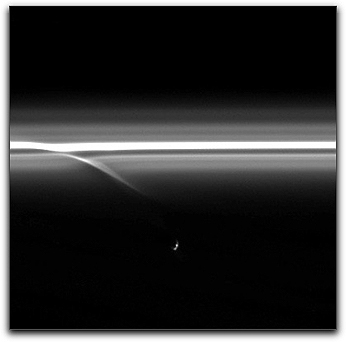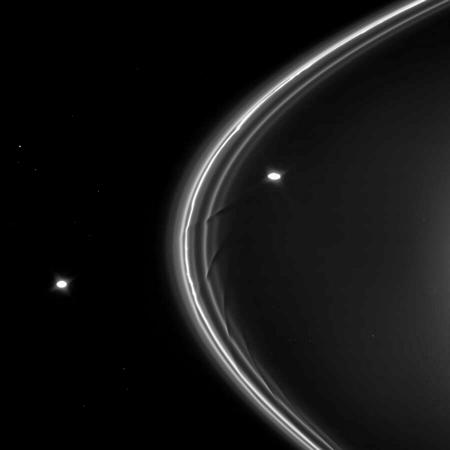This is absolutely astounding! The Cassini spacecraft captured a collision between Saturn’s moon Prometheus and the F ring, which creates a “streamer;” material being pulled from the ring by the moon’s gravity, leaving behind a dark channel. There’s even a movie of the event! The creation of these streamers and channels occurs in a cycle that repeats during each of Prometheus’ orbits. During its 14.7 hour orbit of Saturn, when Prometheus reaches apoapse, or where it is farthest away from Saturn and closest to the F ring, the oblong moon draws a streamer of material from the ring. But since Prometheus orbits faster than the material in the ring, this new streamer is pulled from a different location in the ring about 3.2 degrees (in longitude) ahead of the previous one. In this way, a whole series of streamer-channels is created along the F ring, and Cassini has captured more images showing what are called streamer-channels.
New images, as the one below, again look at the streamer-channels. This image looks toward the unilluminated side of the rings from about 36 degrees above the ringplane. The image was taken in visible light with the Cassini spacecraft narrow-angle camera on September 30, 2008. The view was acquired at a distance of approximately 970,000 kilometers (602,000 miles) from Saturn and at a Sun-ring-spacecraft, or phase, angle of 45 degrees. Image scale is 5 kilometers (3 miles) per pixel.

In some observations, 10 to 15 streamer-channels can easily be seen in the F ring at one time (at left). Eventually, a streamer-channel disappears as shearing forces (i.e., Keplerian shear) act to disperse the constituent dust particles.
The movie shows just under half of a complete streamer-channel cycle. The dark frames in the movie represent the period during which Prometheus and the F ring pass through Saturn’s shadow. The images in the movie were acquired by the Cassini spacecraft narrow-angle camera on November 23 and 24, 2006. The movie sequence consists of 72 clear spectral filter images taken every 10.5 minutes over a period of about 12.5 hours.
Source: Cassini,



Well, I for one voted for these particular movies , when was it, last year during the contest at Carolyn Porco’s site, as my favorites. I still e-mail the links to people.
Wow. Just wow!
Anybody want to explain what is happening in the movie that causes Prometheus to appear to be impossibly reversing course as it nears the ring?
The people who designed these space explorers deserve medals.
Mike I can answer your question!
Gravity.
Throw a rock up in the air, you’ll miraculously see the same thing happen.
Thanks, azzclown. ( : No doubt mass, velocity and distance are involved as well.
I was hoping for an answer involving perspective and orbits.
Mechanical determinism at it’s best. Particles behave like they ought to. All determined by the law of cause and effect. The ancients would have been fascinated, but maybe this Saturnian landscape looks so terribly dead, because ET’s free will cannot emerge within 17th century determinism.
There is an article on this in the Nov/Dec “StarDate”, The Univ. of TX at Austin McDonald Observatory, pg 15 by Rebecca Johnson.
This is very coo I wonder if it is in color?
You are looking from a prospective roughly perpendicular to the position of Promethius. Think of the motion of a bike pedal ring relative to a cyclist’s foot.
Thanks, Jerry. I understand what is happening now. Somehow the movie had me thinking that it was wobbling north/south near the equatorial (without crossing the actual equitorial line).